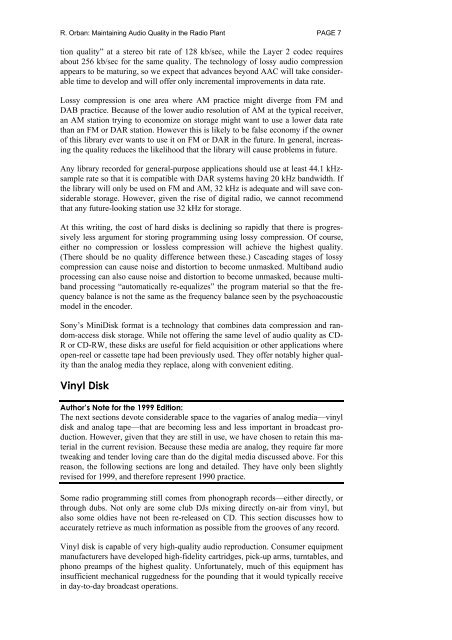Maintaining Audio Quality in the FM Plant - Orban
Maintaining Audio Quality in the FM Plant - Orban
Maintaining Audio Quality in the FM Plant - Orban
Create successful ePaper yourself
Turn your PDF publications into a flip-book with our unique Google optimized e-Paper software.
R. <strong>Orban</strong>: <strong>Ma<strong>in</strong>ta<strong>in</strong><strong>in</strong>g</strong> <strong>Audio</strong> <strong>Quality</strong> <strong>in</strong> <strong>the</strong> Radio <strong>Plant</strong> PAGE 7<br />
tion quality” at a stereo bit rate of 128 kb/sec, while <strong>the</strong> Layer 2 codec requires<br />
about 256 kb/sec for <strong>the</strong> same quality. The technology of lossy audio compression<br />
appears to be matur<strong>in</strong>g, so we expect that advances beyond AAC will take considerable<br />
time to develop and will offer only <strong>in</strong>cremental improvements <strong>in</strong> data rate.<br />
Lossy compression is one area where AM practice might diverge from <strong>FM</strong> and<br />
DAB practice. Because of <strong>the</strong> lower audio resolution of AM at <strong>the</strong> typical receiver,<br />
an AM station try<strong>in</strong>g to economize on storage might want to use a lower data rate<br />
than an <strong>FM</strong> or DAR station. However this is likely to be false economy if <strong>the</strong> owner<br />
of this library ever wants to use it on <strong>FM</strong> or DAR <strong>in</strong> <strong>the</strong> future. In general, <strong>in</strong>creas<strong>in</strong>g<br />
<strong>the</strong> quality reduces <strong>the</strong> likelihood that <strong>the</strong> library will cause problems <strong>in</strong> future.<br />
Any library recorded for general-purpose applications should use at least 44.1 kHzsample<br />
rate so that it is compatible with DAR systems hav<strong>in</strong>g 20 kHz bandwidth. If<br />
<strong>the</strong> library will only be used on <strong>FM</strong> and AM, 32 kHz is adequate and will save considerable<br />
storage. However, given <strong>the</strong> rise of digital radio, we cannot recommend<br />
that any future-look<strong>in</strong>g station use 32 kHz for storage.<br />
At this writ<strong>in</strong>g, <strong>the</strong> cost of hard disks is decl<strong>in</strong><strong>in</strong>g so rapidly that <strong>the</strong>re is progressively<br />
less argument for stor<strong>in</strong>g programm<strong>in</strong>g us<strong>in</strong>g lossy compression. Of course,<br />
ei<strong>the</strong>r no compression or lossless compression will achieve <strong>the</strong> highest quality.<br />
(There should be no quality difference between <strong>the</strong>se.) Cascad<strong>in</strong>g stages of lossy<br />
compression can cause noise and distortion to become unmasked. Multiband audio<br />
process<strong>in</strong>g can also cause noise and distortion to become unmasked, because multiband<br />
process<strong>in</strong>g “automatically re-equalizes” <strong>the</strong> program material so that <strong>the</strong> frequency<br />
balance is not <strong>the</strong> same as <strong>the</strong> frequency balance seen by <strong>the</strong> psychoacoustic<br />
model <strong>in</strong> <strong>the</strong> encoder.<br />
Sony’s M<strong>in</strong>iDisk format is a technology that comb<strong>in</strong>es data compression and random-access<br />
disk storage. While not offer<strong>in</strong>g <strong>the</strong> same level of audio quality as CD-<br />
R or CD-RW, <strong>the</strong>se disks are useful for field acquisition or o<strong>the</strong>r applications where<br />
open-reel or cassette tape had been previously used. They offer notably higher quality<br />
than <strong>the</strong> analog media <strong>the</strong>y replace, along with convenient edit<strong>in</strong>g.<br />
V<strong>in</strong>yl Disk<br />
Author’s Note for <strong>the</strong> 1999 Edition:<br />
The next sections devote considerable space to <strong>the</strong> vagaries of analog media—v<strong>in</strong>yl<br />
disk and analog tape—that are becom<strong>in</strong>g less and less important <strong>in</strong> broadcast production.<br />
However, given that <strong>the</strong>y are still <strong>in</strong> use, we have chosen to reta<strong>in</strong> this material<br />
<strong>in</strong> <strong>the</strong> current revision. Because <strong>the</strong>se media are analog, <strong>the</strong>y require far more<br />
tweak<strong>in</strong>g and tender lov<strong>in</strong>g care than do <strong>the</strong> digital media discussed above. For this<br />
reason, <strong>the</strong> follow<strong>in</strong>g sections are long and detailed. They have only been slightly<br />
revised for 1999, and <strong>the</strong>refore represent 1990 practice.<br />
Some radio programm<strong>in</strong>g still comes from phonograph records—ei<strong>the</strong>r directly, or<br />
through dubs. Not only are some club DJs mix<strong>in</strong>g directly on-air from v<strong>in</strong>yl, but<br />
also some oldies have not been re-released on CD. This section discusses how to<br />
accurately retrieve as much <strong>in</strong>formation as possible from <strong>the</strong> grooves of any record.<br />
V<strong>in</strong>yl disk is capable of very high-quality audio reproduction. Consumer equipment<br />
manufacturers have developed high-fidelity cartridges, pick-up arms, turntables, and<br />
phono preamps of <strong>the</strong> highest quality. Unfortunately, much of this equipment has<br />
<strong>in</strong>sufficient mechanical ruggedness for <strong>the</strong> pound<strong>in</strong>g that it would typically receive<br />
<strong>in</strong> day-to-day broadcast operations.



![[PDF] Using the ITU BS.1770-2 and CBS Loudness Meters ... - Orban](https://img.yumpu.com/50629372/1/190x245/pdf-using-the-itu-bs1770-2-and-cbs-loudness-meters-orban.jpg?quality=85)






![[PDF] Optimod-FM Feature Comparison - Orban](https://img.yumpu.com/41741615/1/190x245/pdf-optimod-fm-feature-comparison-orban.jpg?quality=85)






